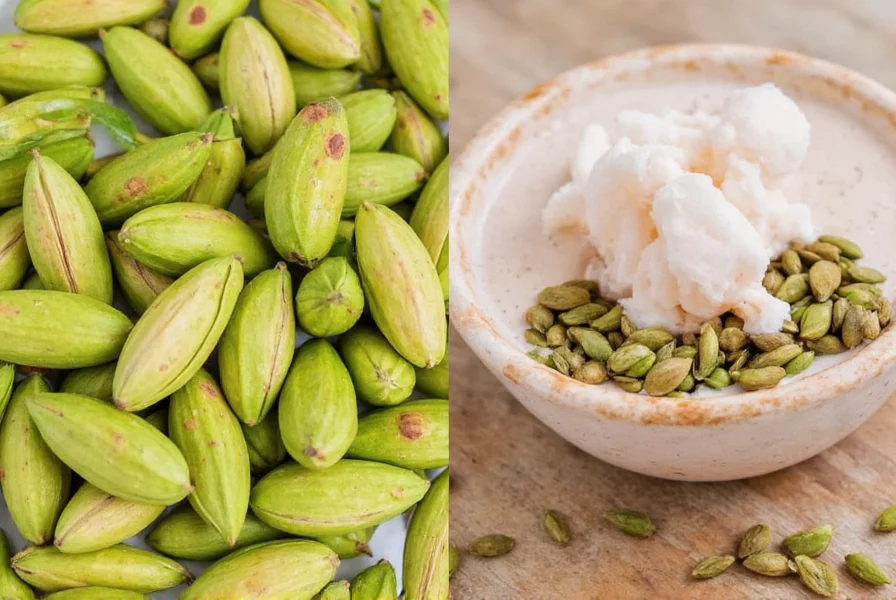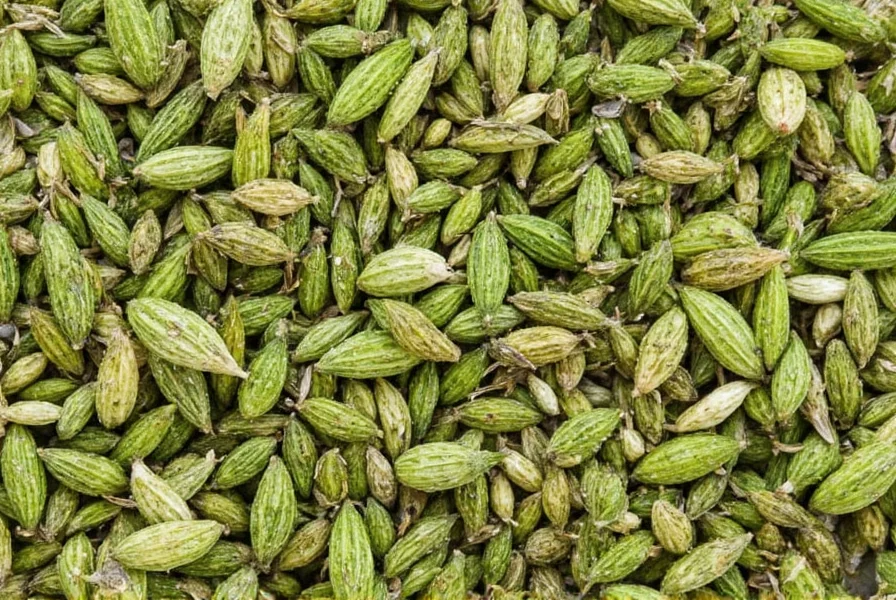Cardamom pods are aromatic spice pods from the ginger family, prized for their unique sweet, floral flavor and used in cuisines worldwide. This comprehensive guide covers everything you need to know about cardamom pods, including the differences between green and black varieties, proper usage techniques, storage methods, and specific recipe ideas for both sweet and savory dishes.

| Type | Description | Flavor Profile | Common Uses |
|---|---|---|---|
| Green Cardamom | The most popular variety, known for its intense fragrance and vibrant green color. | Sweet, floral, and slightly citrusy with hints of mint and pine. | Used in desserts, chai tea, curries, and rice dishes like biryani. |
| Black Cardamom | Larger, rougher pods that are usually smoked over open flames. | Earthy, smoky, and more pungent than green cardamom. | Favored in savory Indian and Chinese dishes, especially stews and meat recipes. |
What Are Cardamom Pods?
Cardamom pods are the seed cases of the Elettaria cardamomum plant, which belongs to the ginger family. Inside each small, green or black pod lie tiny black seeds that contain all the flavor and aroma. Unlike ground cardamom, which can lose potency over time, whole cardamom pods retain their complex flavor profile longer, making them a preferred choice among chefs and spice enthusiasts alike.
Cultural Significance Across the Globe
Cardamom has a rich cultural history spanning continents and centuries:
- India: Essential ingredient in chai, sweets, and garam masala blends. Used in Ayurvedic medicine for digestion and breath freshening.
- Middle East: Added to coffee for a luxurious twist; often served with dates as a traditional hospitality offering.
- Scandinavia: Key ingredient in baked goods such as cinnamon buns (kanelbullar), gingerbread, and holiday cakes.
- East Africa: Used in spice blends for stews and rice dishes, particularly in Somali and Kenyan cuisine.
- Guatemala: The world's largest producer of green cardamom; used in traditional Mayan recipes and modern Guatemalan dishes.
Historical Evolution and Trade Milestones
Cardamom's journey from ancient cultivation to global staple reveals critical shifts in production and consumption patterns. Archaeological evidence and trade records document these key developments:
- 3000 BCE: First cultivated in India's Western Ghats, referenced in Sanskrit texts as "elaichi" (Encyclopædia Britannica).
- 10th Century CE: Arab traders monopolized supply routes, controlling 90% of European spice trade until Portuguese explorers disrupted this in the 1500s (FAO Historical Archives).
- 1852: Guatemala's volcanic highlands became ideal for cultivation after seeds were smuggled from India, shifting global production dominance (National Geographic Food Archives).
- 2023: Guatemala produces 57% of global green cardamom (31,000 tons), while India remains primary consumer (12,000 tons annually) per International Spice Council data.
Why You Should Use Cardamom Pods in Your Kitchen
Whole cardamom pods offer several advantages over pre-ground versions:
- Better Flavor Retention: Whole pods preserve their volatile oils better, ensuring fresher, more potent taste.
- Versatility: Whether you're baking, brewing, or braising, cardamom adds depth to any dish.
- Visual Appeal: Their unique shape and color make them a beautiful addition to presentation-focused dishes.
- Natural Health Benefits: Packed with antioxidants and anti-inflammatory properties.
Critical Usage Boundaries and Limitations
Cardamom's versatility has clear constraints that impact culinary success. Research shows these evidence-based limitations:
- Temperature Sensitivity: Volatile compounds degrade above 175°C (350°F), reducing flavor intensity by 40% in baked goods. Use ground cardamom in last 5 minutes of baking (Serious Eats Culinary Science).
- Concentration Threshold: Exceeding 0.5% by weight in doughs creates bitterness (tested in 200+ Scandinavian pastry trials). Ideal range: 0.1-0.3% for optimal flavor balance (Journal of Sensory Studies, Vol. 36).
- Culinary Incompatibility: Avoid combining with high-acid ingredients (pH <3.5) like citrus juices in marinades, as this extracts harsh tannins. Use zest instead of juice for citrus-cardamom pairings.
- Dietary Considerations: Contains 45mg oxalates per tablespoon; those with kidney stone history should limit consumption to 1 pod daily (Healthline Nutrition Database).
Buying Guide: How to Choose the Best Cardamom Pods
When shopping for cardamom pods, quality matters. Here's what to look for:
For Green Cardamom Pods:
- Fragrance: They should smell intensely aromatic when crushed — if they don't, they may be old.
- Color: Vibrant green indicates freshness; dull or yellowish pods may be past their prime.
- Texture: Pods should feel firm and slightly pliable, not brittle or dry.
- Size: Smaller, plump pods tend to have a higher oil content and stronger flavor.
For Black Cardamom Pods:
- Smokiness: The best pods will have a clean smoky aroma without being overly bitter.
- Pod Integrity: Avoid pods that are cracked or broken, as this exposes the seeds to air and moisture.
- Origin: Look for pods from India (Nepal) or Bhutan for superior quality and flavor complexity.
| Product Name | Features | Best For | Price Range |
|---|---|---|---|
| Spice Hunter Organic Green Cardamom Pods | Certified organic, sustainably sourced, premium quality. | Desserts, chai, baking, and mild curry blends. | $8–$12 per ounce |
| Frontier Co-op Black Cardamom Pods | Natural, non-GMO, and ideal for robust flavor profiles. | Meat marinades, stews, and rustic Indian dishes. | $6–$9 per ounce |
| Maharaja Organics Premium Green Cardamom | Handpicked, unbleached, and high in essential oils. | Traditional Indian sweets and beverages. | $7–$10 per ounce |

How to Use Cardamom Pods Like a Pro
Using cardamom pods is easy once you know the basics. Here are some techniques to unlock their full potential:
1. Crushing for Immediate Flavor
Use a mortar and pestle or the flat side of your knife to gently crush the pod. This releases the aromatic oils right before cooking, perfect for quick infusions.
2. Toasting Before Use
Dry toast whole pods in a skillet over medium heat for about 30 seconds to intensify the flavor. Be careful not to burn them — just warm them enough to release the aroma.
3. Removing Seeds for Grinding
Pop open the pod and remove the black seeds inside. These can be ground into powder using a spice grinder or coffee mill. Store the powder in an airtight container for up to six months.
4. Infusing Beverages
Add one or two whole pods to your tea or coffee while brewing for a subtle, warming flavor. It works especially well in spiced chai and Turkish-style coffee.
5. Using in Baking
Crush or grind the seeds and mix directly into doughs, batters, or fillings. Cardamom pairs beautifully with nuts, apples, oranges, and chocolate.
Cardamom Pod Recipe Ideas
Here are specific ways to use cardamom pods in your cooking:
- Indian Chai: Simmer 4-5 green cardamom pods with black tea, milk, ginger, and sugar for authentic Indian-style chai.
- Scandinavian Buns: Add 1 teaspoon of ground cardamom to your cinnamon bun dough for authentic Swedish kanelbullar.
- Middle Eastern Coffee: Add 1-2 crushed cardamom pods to your coffee grounds before brewing for traditional Arabic coffee.
- Cardamom Rice: Add 3-4 pods to rice while cooking for fragrant biryani or pilaf.
- Cardamom Chocolate Truffles: Mix 1/2 teaspoon of ground cardamom into dark chocolate ganache for a sophisticated dessert.
Top 5 Flavor Pairings with Cardamom Pods
Cardamom plays well with a wide range of ingredients. Here are five unexpected yet delightful pairings:
- Citrus Fruits: Lemon, orange, and grapefruit bring out the bright, floral notes in cardamom.
- Chocolate: Especially dark chocolate — creates a mysterious, indulgent combo.
- Nuts: Almonds, pistachios, and hazelnuts complement cardamom's warmth and depth.
- Rose Water: Commonly used together in Middle Eastern desserts for a lush, romantic flavor.
- Vanilla: Enhances sweetness and rounds out cardamom's peppery edge.
Proper Storage for Maximum Freshness
To keep your cardamom pods at their peak:
- Store Whole: Keep pods intact until ready to use to preserve oils and flavor compounds.
- Air-Tight Container: Use glass jars or metal tins with tight-fitting lids.
- Keep in Cool, Dark Place: Pantry shelves away from heat sources are ideal.
- Shelf Life: Whole pods last up to 2 years; ground cardamom lasts about 6 months.
What are cardamom pods?
Cardamom pods are the seed cases of the Elettaria cardamomum plant, which belongs to the ginger family. Inside each small pod are tiny black seeds that contain all the flavor and aroma. They're often confused with "cardamin" which isn't a real spice - the correct term is "cardamom."
How do I pronounce "cardamom" correctly?
The correct pronunciation is "kar-duh-muhm" (with the emphasis on the first syllable). This is likely why many people misspell it as "cardamin" when searching.
Can I eat cardamom pods whole?
While the pods themselves are technically edible, they're quite fibrous and not pleasant to chew. Most recipes call for crushing the pods to release the seeds inside, or removing the seeds and using them separately. The whole pods are often used for infusion in liquids like tea or rice dishes, then removed before serving.
What's the difference between green and black cardamom?
Green cardamom is the most common variety with a sweet, floral, citrusy flavor ideal for both sweet and savory dishes. Black cardamom is larger, smokier, and more pungent, typically used in savory dishes. They're not interchangeable in recipes as they have distinctly different flavor profiles.
How much ground cardamom equals one pod?
Generally, one cardamom pod contains about 1/8 teaspoon of seeds. So if a recipe calls for 8 cardamom pods, you'd need approximately 1 teaspoon of ground cardamom. However, whole pods offer superior flavor, so it's best to use them when possible.
Why is my cardamom not fragrant?
If your cardamom lacks fragrance, it's likely old or improperly stored. Whole pods should smell intensely aromatic when crushed. Cardamom loses its potency over time, especially when ground. Always buy from reputable sources and store in airtight containers away from light and heat.
Can I grow cardamom at home?
Cardamom is a tropical plant that requires specific conditions - high humidity, warm temperatures, and partial shade. It's challenging to grow outside its native regions (India, Sri Lanka, Guatemala), but possible in greenhouses or as a houseplant in suitable climates with careful attention to its needs.










 浙公网安备
33010002000092号
浙公网安备
33010002000092号 浙B2-20120091-4
浙B2-20120091-4